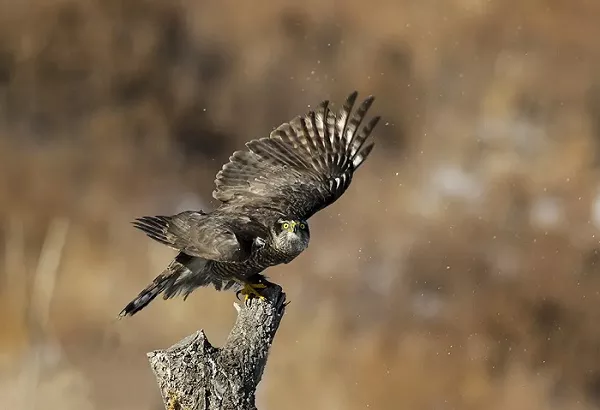The Northern Goshawk, scientifically known as Accipiter gentilis, is a fierce and majestic bird of prey that inhabits the forests of the Northern Hemisphere. It is the largest member of the Accipiter family, a group of birds that includes other agile hunters like the Cooper’s Hawk and the Sharp-shinned Hawk.
- Description and Physical Characteristics
The Northern Goshawk is a large, stocky raptor, with a broad, powerful body and long, strong legs. It has a wingspan of around 3 feet and can weigh up to 3 pounds, making it one of the largest birds of prey in North America. The Goshawk has short, broad wings that allow it to maneuver quickly through dense forests, and a long, narrow tail that helps it steer and balance in the air.
The plumage of the Northern Goshawk is striking and distinctive. Adults have a slate-gray back and wings, with a white or pale gray breast and belly. The bird’s head is dark, with a bold, white “eyebrow” stripe that extends over the eye. Juvenile birds have a brownish plumage, with streaked breasts and bellies.
- Habitat and Range
The Northern Goshawk is found throughout the boreal forests of North America, Europe, and Asia. It is a bird of the mountains and the deep woods, preferring mature, dense forests with plenty of cover and large trees for nesting. In North America, the bird’s range extends from Alaska and northern Canada down to the northern United States, with scattered populations in the western mountains and the Appalachians.
- Diet and Hunting Behavior
The Northern Goshawk is a fierce and agile hunter, preying on a variety of small to medium-sized mammals and birds. Its preferred prey includes squirrels, rabbits, hares, grouse, and other birds, but it will also take larger prey like ducks, geese, and even small deer on occasion. The bird is known for its remarkable speed and agility in flight, using its long, powerful legs and sharp talons to grab prey out of the air or pounce on it from a perch.
- Breeding and Nesting
The Northern Goshawk is a monogamous bird, forming pair bonds that last for life. Breeding pairs typically establish territories in the early spring, with the male performing elaborate courtship displays to impress the female. The birds build their nests in large trees, usually near the top of the canopy, using sticks, bark, and other materials. The female lays 2-4 eggs, which she incubates for around 35 days. After hatching, the young birds remain in the nest for around 6-7 weeks, being fed by both parents until they fledge and begin to learn to hunt on their own.
- Conservation Status
The Northern Goshawk is considered a species of Least Concern by the International Union for Conservation of Nature (IUCN). However, the bird’s population has declined in some areas due to habitat loss and fragmentation, as well as hunting and persecution by humans. The Goshawk is also vulnerable to contamination by environmental toxins like pesticides and heavy metals, which can affect the bird’s health and reproductive success. Conservation efforts are focused on protecting the bird’s habitat and promoting sustainable forestry practices, as well as monitoring populations and mitigating threats to their survival.
In conclusion, the Northern Goshawk is a fascinating and formidable bird of prey that plays an important role in the ecosystems of the boreal forests of the Northern Hemisphere. With its striking appearance, impressive hunting skills, and vital ecological niche, this bird is a true symbol of the wild and a testament to the power and beauty of nature.


 Facebook
Facebook  Instagram
Instagram  Youtube
Youtube 